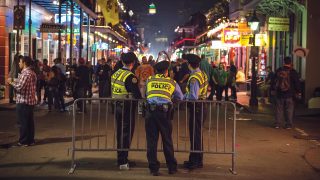
Nationwide, law enforcement leaders are aware of public concerns about “militarization of the police.” With all the expanded oversight and suspicion of law enforcement, I know that maintaining public safety in our communities is harder than ever. In this article, I hope to elucidate some of the fomenting concerns and dispositions that are widely afoot so that law enforcement leaders can assess and respond appropriately within their own community dynamics.
Over the past half-century, many of the 18,000 or so police departments across the United States have increasingly acquired military-grade weaponry, equipment and personal armor. In addition, especially following the terrorist attacks of 9/11, many agencies have augmented their training and tactics, while also incorporating some military styles within SWAT teams.
The research literature on this subject generally agrees that this kind of militarization began during the 1960s with the creation of the first SWAT, at the time called Special Weapons Attack Team, by the LAPD in an effort to combat the proliferation of well-armed youth gangs and increases in violent street crimes. SWAT members underwent military-style combat training and, armed with submachine guns, were deployed to crisis scenes in armored vehicles. After numerous successes, particularly the 1969 apprehension of heavily armed Black Panthers and the highly publicized 1973 takedown of the Symbionese Liberation Army, famous for kidnapping heiress Patty Hearst, agencies across the nation took notice, and soon over half of all U.S. cities with populations of 50,000 and up created their own SWAT units.
In 1989, Section 1033 of the National Defense Authorization Act allowed the secretary of defense to provide surplus military equipment to state and local law enforcement organizations to improve efficiency and safety during anti-drug and counterterrorism operations. After a significant drop in violent crime across the nation through the 1990s, funding, support and enthusiasm for SWAT units took a downturn. But following the terrorist attacks on 9/11, Congress promoted wide distribution of available military equipment in support of homeland security, and the face of America’s police forces transformed as departments large and small became tasked with protecting citizens from a powerful menace that seemed to be invisible and possibly everywhere.
A 2011 edition of The Atlantic noted that as the first line of defense against terrorist attacks on American soil, police agencies of all sizes across the country had significantly expanded their employment of military-grade materials and weaponry, including a range of equipment from body armor to attack-capable helicopters.
From that report: “Police departments have employed their newly acquired military weaponry not only to combat terrorism but also for everyday patrolling… Now, police officers routinely walk the beat armed with assault rifles and garbed in black full-battle uniforms… In recent years, police departments both large and small have acquired bazookas, machine guns, and even armored vehicles (mini-tanks) for use in domestic police work.”
The report also noted that while in the beginning only the largest American cities had SWAT teams, employed only when extraordinary force was required, soon an estimated 89% of police departments in cities with populations of more than 50,000 had SWAT teams, many of them trained by special forces commandos, often deployed as a precaution for relatively minor operations, including serving warrants and performing wellness checks.
While a significant increase in urban street crime was one of the primary factors that started the militarization of America’s police in the contemporary era, and the events of 9/11 accelerated the 1033 Program, there are several causal factors related to the presence of militarized law enforcement across the country. A wide variety of military-grade equipment increasingly acquired by law enforcement agencies is available through a number of federal agencies besides the Department of Defense (DOD), including the Department of Justice (DOJ), Department of Homeland Security (DHS), Treasury Department, Department of the Interior (DOI), General Services Administration (GSA), Defense Logistics Agency (DLA) and Office of National Drug Control Policy (ONDCP).
Only the DOD keeps track of which agencies have received what type of equipment from it, which means that there is no comprehensive tally of who owns what. Once a police agency has possession of military equipment, it is the owner, able to trade or lease those materials to other agencies with nothing tracked by any federal regulatory organization.
The General Accountability Office (GAO), often called the “congressional watchdog,” asserts that the DOD, the only agency that tracks equipment acquisition, does not verify the identities of the individuals who take possession of these materials, nor are the quantities recorded, and that some private security firms, even nonexistent agencies, have acquired military-grade weaponry through the 1033 Program. Additionally, a proliferation of brokers within the federal government, such as the DLA Disposition Services, actively solicit federal, tribal, state and local law enforcement agencies to become owners of military-grade equipment that would otherwise wind up warehoused or on the scrap heap.
An extensive 2018 Stanford University study of 9,000 U.S. law enforcement agencies, published in the Proceedings of the National Academies of Sciences and said to be the first systematic analysis on the use and consequences of militarized force, found that many police agency supervisors consider SWAT teams and other quasi-militarized units necessary for police and public safety. The study also maintains that SWAT teams were much more likely to be used in predominantly Black neighborhoods. In addition, it is claimed that although hundreds of open records requests were sent to police agencies, most of them do not track militarized operations, and those that do keep records sometimes either refuse to share them, erase or redact them, or demand extremely high payments for anyone seeking acquisition.
Another report, prepared for an FBI Law Enforcement Bulletin by the State University of New York Criminal Justice Department, stated that of 370 agencies surveyed, from departments of fewer than 25 officers to those above 500, the results indicated that “police agencies will not shy away from using [SWAT] teams for [any] incidents they see as potentially dangerous.” Seventy percent of the leaders said that SWAT deployment practices would not be altered for a protest or civil unrest, with a majority of respondents considering it unnecessary to make changes in the use of black or camouflage uniforms, armored vehicles or military-style rifles, despite the widespread acknowledgment that most of the public sees their militarized appearance as unacceptable.
Along with the Stanford study, these findings indicate that police culture, regardless of the agency’s size, has come to identify with a more militarized style since that first L.A. SWAT team began in the late 1960s, and America’s police have been stockpiling easily accessible military equipment and embracing military-style training. According to the aforementioned Atlantic report, contemporary police have been transforming the characteristics of peace officers into those of soldiers.
President Obama decided to significantly limit access to the DOD’s 1033 Program in 2014 following the extreme show of military might by the Ferguson Police Department during the riots that followed the Michael Brown shooting, but in 2107 President Trump authorized a robust expansion of the program. Some individual states have attempted to address concerns associated with police militarization. Maryland enacted a short-lived law requiring every police agency in the state to record its SWAT activity in a uniform, transparent manner, following a raid on a local mayor’s home that resulted in traumatizing his family and the death of his dogs. New Jersey requires police agencies to receive approval from local legislators before obtaining military equipment. Montana enacted a law restricting state and local police from obtaining certain military equipment from the 1033 Program, such as weaponized drones, combat aircraft, grenade launchers, silencers and militarized armored vehicles. Police there must also issue a public notice 14 days before requesting any military-grade equipment, and may not use any grant funding for the purchase of 1033 materials.
For over a half-century, numerous police departments across the U.S., large and small, have acquired and regularly use military-grade equipment, weaponry and outerwear. However, there has also been an increased groundswell among community leaders, academics, lawmakers, civil rights activists and criminal justice authorities who want to see this trend curtailed. There have been numerous attempts to limit access to military equipment or to require more accountability, such as Campaign Zero, a citizen activist group that seeks to demilitarize America’s police. High on their list is to do away with the 1033 Program altogether, which would require congressional legislation. An extensive coalition of over five dozen civil liberties and public policy organizations signed open letters to congressional leadership urging a halt to the program, as well as for hearings to be conducted about its usefulness, including the National Association of Criminal Defense Lawyers, The Constitution Project, ACLU, FreedomWorks, NAACP, the Law Enforcement Action Partnership and numerous others groups from the left, right and in between, all opposed to employing weapons of war in domestic law enforcement.
Law enforcement’s mission is harder and more dangerous than ever. Public perception and support are quite low. And watchdog agencies and groups, regardless of their legitimacy and motives, hold more sway than ever. I hope that this article is a good summary of this hot-button issue so that wise law enforcement leaders can navigate these roiling waters for the optimal safety of their staff and the communities they serve.
As seen in the October 2023 issue of American Police Beat magazine.
Don’t miss out on another issue today! Click below:






